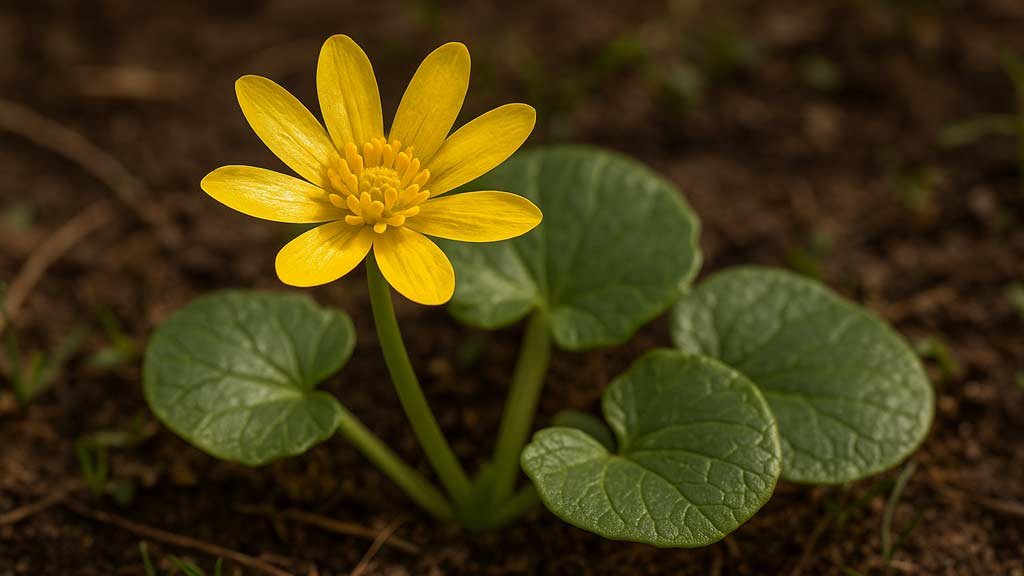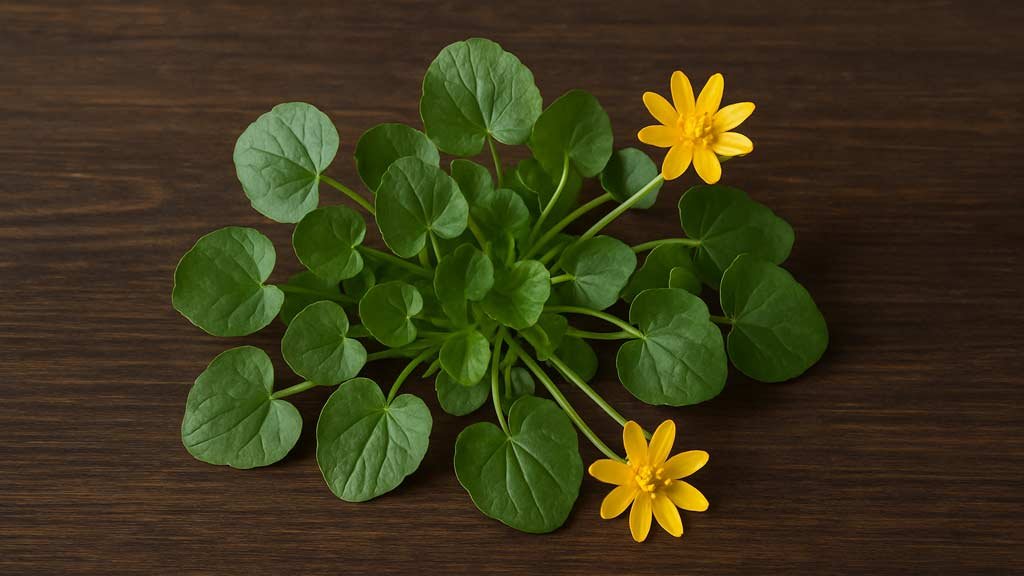A Delicate Flower with Strong Roots
Lesser Celandine (Ficaria verna), sometimes called pilewort, is a small, unassuming plant with shiny, heart-shaped leaves and bright yellow, buttercup-like flowers. Despite its delicate appearance, it has a long history in traditional herbal medicine, particularly for treating hemorrhoids and minor skin problems. Its cheerful blooms are a promise of early spring, often appearing before the first leaves of other plants, a hint of vitality after the long winter.
You might walk past a patch and barely notice it, but for centuries, herbalists and folk healers have valued its roots, leaves, and flowers. Something is grounding about a plant that thrives quietly in shaded meadows and stream banks, offering potent remedies without fanfare.
Table of Contents
Botanical and Chemical Composition
Lesser Celandine contains several bioactive compounds that contribute to its traditional uses:
- Protoanemonin: Found in fresh leaves and roots, this compound has mild antiseptic and astringent properties
- Flavonoids: Support antioxidant activity and reduce inflammation
- Tannins: Provide astringent effects helpful for minor bleeding and tissue tightening
- Resin and mucilage: Offer soothing qualities for irritated tissues
The balance of these compounds explains why Lesser Celandine was historically applied both topically and internally in carefully prepared forms.
Historical and Folk Uses
The plant’s most renowned use is for hemorrhoids—hence its common name, pilewort. Folk medicine describes several methods:
- Poultices: Fresh leaves mashed and applied directly to affected areas to reduce swelling and discomfort
- Tinctures: Alcohol-based extracts used sparingly to ease irritation
- Infusions: Mild teas consumed in very controlled amounts
Aside from hemorrhoid care, Lesser Celandine was also applied to:
- Minor cuts or abrasions to reduce inflammation and aid healing
- Skin rashes and mild eczema to soothe irritation
- Varicose veins, where its astringent properties could improve circulation
Anecdotal Evidence
Folk tales describe herbalists harvesting Lesser Celandine in early spring, noting its timing coincided with seasonal “spring cleaning” of the body—digestive, circulatory, and skin health aligned with the plant’s availability. Users often spoke of gentle relief, not dramatic cures, but a calming, restorative effect on tissues and discomfort.
How Lesser Celandine Works
The plant’s astringent and anti-inflammatory compounds explain its traditional effectiveness:
- Astringency: Tannins tighten tissues, reducing minor bleeding and swelling in hemorrhoidal veins
- Anti-inflammatory action: Flavonoids soothe irritation in skin and mucous membranes
- Antimicrobial potential: Protoanemonin exhibits mild antibacterial effects, supporting minor wound care
These mechanisms are subtle yet reliable when used with care and knowledge.
Preparation and Application Methods
Preparation is crucial because the fresh plant contains compounds that can be irritating if misused. Traditional techniques include:
- Poultices: Fresh leaves mashed and applied externally; always check skin sensitivity first
- Tinctures: Alcohol extracts prepared in controlled amounts for topical or occasional oral use
- Drying: Leaves and roots dried carefully to reduce protoanemonin content, making them safer for infusions
It’s worth noting that modern herbalists often stress moderation and proper preparation to prevent toxicity.
Skin Health Benefits
Beyond hemorrhoid care, Lesser Celandine has a history in skin treatment:
- Minor cuts and abrasions: Applied as a poultice to reduce bleeding and support healing
- Rashes and eczema: Leaves infused in warm water can soothe inflamed skin
- Varicose veins: Topical applications may reduce mild swelling and improve circulation
The plant’s astringent nature provides gentle tightening of tissues while flavonoids support cellular health and reduce redness.
Hemorrhoid Relief
Hemorrhoids are among the most common ailments addressed by Lesser Celandine:
- Topical application: Fresh poultices reduce swelling and discomfort
- Tissue support: Astringent compounds tighten the venous walls
- Inflammation reduction: Flavonoids calm irritation and soothe the area
Traditional practice emphasizes consistency, moderate application, and observation of any adverse reactions.
Cautions and Safety
Lesser Celandine can be toxic if misused. Protoanemonin, in particular, is a skin irritant and can be harmful if ingested in large amounts. Safe use guidelines include:
- Avoid raw consumption of fresh leaves
- Only apply poultices externally in small areas to test sensitivity
- Prepare tinctures or infusions according to traditional ratios to minimize risk
- Pregnant or breastfeeding women should avoid internal use
- Discontinue if any irritation, rash, or adverse reaction occurs
Moderation is key, and respecting the plant’s potency ensures benefits without harm.
Seasonal and Cultivation Considerations
Lesser Celandine is a spring ephemeral, appearing early and disappearing by late spring. This timing aligns with traditional “spring cleansing” practices. Cultivation is relatively simple:
- Prefers moist, shaded soils and partial sunlight
- Propagates through tubers and seeds
- Requires minimal care once established
Harvesting should be done ethically: leave enough for the plant to regenerate and avoid disturbing wild populations excessively.
Integrating into Daily Life
For those interested in traditional herbal practices, Lesser Celandine can be integrated thoughtfully:
- Topical support: Occasional poultices for mild swelling or irritation
- Observation: Noting how the body responds to gentle applications
- Seasonal ritual: Align use with early spring, honoring traditional timing
It’s not a daily tonic but a seasonal, focused remedy, much like nature intended.

Modern Research and Evidence
Contemporary studies confirm some traditional uses:
- Astringent properties: Tannins help tighten tissues
- Anti-inflammatory potential: Flavonoids reduce irritation in vitro
- Mild antimicrobial effects: Protoanemonin can inhibit certain bacteria
However, clinical evidence for hemorrhoid treatment in controlled studies is limited, and caution is emphasized due to potential toxicity. The plant’s folk status remains strong, but it’s best used with knowledge and respect.
Combining with Complementary Herbs
Lesser Celandine can be combined with other mild herbs to enhance its soothing effects:
- Witch hazel: Enhances astringency and reduces swelling
- Calendula: Soothes skin and supports healing
- Aloe vera: Provides cooling, protective effects for irritated tissue
These combinations honor the plant’s traditional context while integrating modern herbal understanding.
Summary of Benefits
- Hemorrhoid relief: Reduces swelling, irritation, and discomfort
- Skin care: Supports healing of minor wounds, rashes, and varicose veins
- Astringent support: Tightens tissues and promotes circulation
- Antioxidant and anti-inflammatory: Mild protective effects for skin and veins
Used carefully, Lesser Celandine is a gentle, reliable plant ally.
Final Thoughts
Lesser Celandine is a testament to the wisdom of folk medicine. Its small, sunny flowers hide a potent capacity to soothe discomfort, support skin health, and provide gentle relief for hemorrhoids. It’s not flashy, it doesn’t promise overnight cures, but it rewards careful, respectful use with subtle, effective benefits.
In the world of herbal medicine, sometimes the quietest plants hold the most profound lessons: patience, respect, and attentive observation. Lesser Celandine is one such plant, offering relief in the humble, radiant way that only nature can provide.
Article Sources
At AncientHerbsWisdom, our content relies on reputable sources, including peer-reviewed studies, to substantiate the information presented in our articles. Our primary objective is to ensure our content is thoroughly fact-checked, maintaining a commitment to accuracy, reliability, and trustworthiness.
- American Herbal Products Association. (2021). Botanical safety handbook (2nd ed.). CRC Press.
- Chevallier, A. (1996). The encyclopedia of medicinal plants: A practical reference guide to the medicinal properties of over 300 key herbs and their medicinal uses. DK Publishing.
- Grieve, M. (1971). A modern herbal: The medicinal, culinary, cosmetic and economic properties, cultivation, and folklore of herbs, grasses, fungi, shrubs, & trees with all their modern scientific uses. Dover Publications.
- Hager, H. (1900). Hager’s handbuch der pharmazeutischen praxis für apotheker, ärzte, drogisten und medicinbeamte. Springer.
- Lewis, R. A. (1998). Lewis’ dictionary of toxicology. CRC Press.
- Yilmaz, B., Yilmaz, B., Aktaş, B., Unlu, O., & Roach, E. C. (2015). Lesser Celandine (Pilewort) Induced Acute Toxic Liver Injury: The First Case Report Worldwide. World Journal of Hepatology, 7(5), 744–748. https://doi.org/10.4254/wjh.v7.i5.744

